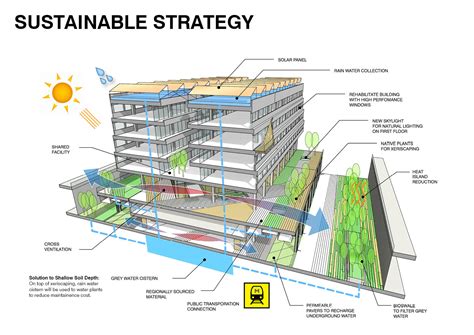In recent years, there has been a growing demand for sustainable structures, driven by the increasing awareness of the environmental impact of traditional building practices. As a result, American universities have been at the forefront of integrating sustainability into their architecture and engineering programs. This has led to the emergence of green building programs that focus on promoting sustainable design principles, fostering interdisciplinary collaboration, and providing hands-on sustainable construction experience. Moreover, these programs are also implementing sustainable materials and technologies, and measuring and assessing their environmental impact. Furthermore, universities are engaging in community outreach and education to create a culture of sustainability on their campuses. In this blog post, we will explore the impact of these green building programs in American universities and how they are influencing the next generation of architects, engineers, and designers to prioritize sustainability in their future projects.
Table of Contents
Growing demand for sustainable structures
In recent years, there has been a growing demand for sustainable structures as people become more aware of the impact of traditional construction methods on the environment. This shift in consciousness has led to an increase in the use of environmentally friendly materials and innovative construction techniques.
Architects, engineers, and developers are now facing the challenge of creating buildings that not only meet the needs of the present but also consider the long-term impact on our planet. This has prompted the emergence of green building programs that aim to promote the use of sustainable design principles and materials.
As consumers continue to prioritize eco-friendly options, the integration of sustainability into existing curricula has become essential. Young professionals in the construction industry are being encouraged to adopt sustainable practices and consider the environmental impact of their projects from the early stages of development.
The growing demand for sustainable structures has also led to a greater emphasis on community outreach and education. Organizations and institutions are taking the initiative to educate the public about the benefits of sustainable construction and how they can contribute to creating a culture of sustainability in their communities.
Emergence of green building programs
In recent years, there has been a significant emergence of green building programs aimed at promoting sustainable building practices. These programs have gained traction as a response to the growing demand for environmentally friendly and energy-efficient structures. By incorporating sustainable design principles, such as efficient use of resources and reduction of waste, these programs have revolutionized the construction industry.
One key aspect of the emergence of green building programs is the integration of sustainability into existing curricula. Educational institutions have recognized the need to equip future builders and architects with the knowledge and skills to implement sustainable practices. This has led to the development of specialized courses and degree programs focused on green building and sustainable design.
Another important factor driving the emergence of green building programs is the fostering of interdisciplinary collaboration. Architects, engineers, and environmental experts are collaborating to create innovative solutions for sustainable construction. This multi-disciplinary approach ensures that green building programs are comprehensive and effective in addressing environmental challenges.
Furthermore, green building programs are also focused on providing hands-on sustainable construction experience. Students and professionals are given the opportunity to work on real-life projects that incorporate sustainable materials and technologies. This practical experience is essential for fostering a culture of sustainability and promoting the widespread adoption of green building practices.
Integration of sustainability into existing curricula
In today’s world, it is becoming increasingly vital to integrate sustainability into existing curricula across all educational institutions. As the global focus on environmental conservation and responsible resource management grows, it is imperative that students are equipped with the knowledge and skills to address these critical issues in their future careers. By integrating sustainability into existing curricula, educational institutions can play a pivotal role in preparing the next generation of innovators, leaders, and changemakers.
The integration of sustainability into existing curricula takes many forms. It may involve incorporating sustainability-focused modules into existing courses, developing new courses specifically dedicated to sustainability, or infusing sustainability principles across multiple disciplines. By doing so, students from diverse academic backgrounds can be exposed to the core tenets of sustainability, including environmental stewardship, social responsibility, and economic viability.
Moreover, the integration of sustainability into existing curricula fosters a culture of awareness and proactive engagement with environmental and social issues. It empowers students to think critically about the impact of their work and the decisions they make, both within and beyond the academic context. This holistic approach to education not only enriches students’ learning experiences but also prepares them to be responsible global citizens who are capable of effecting positive change in society.
Educational institutions have a unique opportunity to lead by example and inspire their students to champion sustainable practices in all aspects of their personal and professional lives. The integration of sustainability into existing curricula is not just an educational imperative; it is a conscious effort to cultivate a generation of thought leaders who are committed to shaping a more sustainable and equitable future for all.
Promoting sustainable design principles
In today’s world, the promotion of sustainable design principles is more important than ever. With the increasing awareness of climate change and the impact of human activities on the environment, it has become imperative for individuals and organizations to prioritize sustainable practices in all aspects of life, including design and construction.
One of the key ways to promote sustainable design principles is by educating and raising awareness among architects, engineers, builders, and other design professionals. This can be done through workshops, seminars, and training programs that focus on the importance of reducing energy consumption, minimizing waste, and using environmentally friendly materials in construction projects.
Another effective way to promote sustainable design principles is by advocating for and implementing green building codes and standards. By making it mandatory for new construction and renovation projects to meet certain sustainability criteria, governments and regulatory bodies can encourage the adoption of eco-friendly design practices.
Furthermore, the collaboration between different stakeholders in the construction industry, including designers, builders, and clients, plays a crucial role in promoting sustainable design principles. By working together to prioritize environmental stewardship and incorporating sustainable practices into project requirements, a culture of sustainability can be established within the industry.
Fostering interdisciplinary collaboration
In today’s world, the importance of fostering interdisciplinary collaboration when it comes to sustainable construction and design cannot be overstated. It is essential for experts from various fields to come together and work towards a common goal of creating sustainable structures that benefit both the environment and society. By promoting collaboration between architects, engineers, environmental scientists, and urban planners, we can harness the collective expertise and skills of these professionals to address complex sustainability challenges.
Interdisciplinary collaboration encourages the exchange of ideas and perspectives, leading to innovative and holistic approaches to sustainable construction. When individuals from different backgrounds share their knowledge and experiences, they can identify potential solutions that may have been overlooked if working within a single discipline. This collaborative effort can result in the development of sustainable design principles that are both effective and practical.
Moreover, fostering interdisciplinary collaboration in the field of sustainable construction can pave the way for the integration of new and emerging technologies and materials that can greatly reduce the environmental impact of construction projects. By bringing together experts in various fields, we can explore and implement innovative methods that prioritize environmental stewardship without sacrificing structural integrity or functionality.
Ultimately, fostering interdisciplinary collaboration is essential for advancing sustainable construction practices and creating a built environment that is in harmony with nature. By breaking down traditional silos and encouraging professionals from different disciplines to work together, we can accelerate the transition towards a more sustainable and resilient future.
Providing hands-on sustainable construction experience
One of the key components of preparing the next generation for sustainable design and construction careers is providing hands-on sustainable construction experience. This type of experience allows students to gain a practical understanding of the challenges and opportunities in sustainable construction, as well as the skills and knowledge needed to implement sustainable design principles in real-world projects. By engaging students in hands-on projects, educators can foster a deeper appreciation for the importance of sustainability in construction and inspire them to pursue careers in this field.
Hands-on experience in sustainable construction can take many forms, ranging from building environmentally-friendly structures and systems to implementing renewable energy solutions and sustainable materials. By involving students in these projects, educators can instill a sense of responsibility and innovation, as well as critical thinking and problem-solving skills. Additionally, hands-on experiences can provide students with a platform to develop leadership and teamwork abilities, as sustainability often requires collaboration and communication across multiple disciplines.
Furthermore, providing hands-on sustainable construction experiences can help students gain a comprehensive understanding of the various factors that influence sustainable design and construction. This can include considering the environmental, social, and economic impacts of construction projects, as well as the importance of ethical and sustainable practices. By engaging students in real-world projects, educators can help them develop a holistic perspective on sustainability that goes beyond the technical aspects of construction.
In conclusion, providing hands-on sustainable construction experience is essential for preparing the next generation of construction professionals to address the challenges of sustainability in the built environment. By creating opportunities for students to engage in practical projects and gain firsthand experience, educators can inspire them to become advocates for sustainable construction and design, and empower them to contribute to a more sustainable future.
Implementing sustainable materials and technologies
In recent years, there has been a growing emphasis on sustainable materials and technologies in the construction and design industry. This shift is driven by a greater awareness of the environmental impact of traditional building materials and the need to reduce carbon emissions. As a result, there has been a surge in the development and implementation of innovative green materials and technologies that have the potential to revolutionize the way we build and design structures.
One of the key challenges in implementing sustainable materials and technologies is the need for widespread adoption and integration into existing construction practices. While there are many promising green materials and technologies available, there is still a gap in knowledge and expertise within the industry. This highlights the importance of education and training programs that focus on sustainable construction practices and the use of environmentally-friendly materials.
Another factor to consider is the cost and availability of sustainable materials and technologies. While the initial investment may be higher, the long-term benefits in terms of energy efficiency and environmental impact make them a worthwhile investment. Additionally, as demand for green materials and technologies continues to rise, we can expect to see greater affordability and accessibility in the future.
In conclusion, implementing sustainable materials and technologies is a crucial step towards creating a more environmentally responsible construction industry. Through education, innovation, and investment, we have the potential to transform the way we build and design structures, leading to a more sustainable and eco-friendly future.
Measuring and assessing environmental impact
When it comes to creating a culture of sustainability on campuses, one of the key aspects is measuring and assessing environmental impact. This involves looking at the various ways in which the campus operations, construction projects, and overall activities are impacting the environment. From energy consumption to waste generation, every aspect needs to be carefully evaluated to understand the campus’s environmental footprint.
By measuring the environmental impact, campuses can gain valuable insights into where they are having the most significant effects on the environment. This data provides a starting point for developing sustainability initiatives that can effectively target the areas that are most in need of improvement.
Furthermore, assessing the environmental impact allows campuses to track their progress over time. By setting measurable goals and regularly assessing their performance, they can ensure that their efforts are making a positive impact and identify areas that require further attention. This continuous assessment is essential for ensuring that the campus remains committed to its sustainability objectives.
In addition to the internal benefits of measuring and assessing environmental impact, this practice also provides an opportunity for campuses to showcase their commitment to sustainability to the wider community. By transparently sharing their environmental impact data and demonstrating their efforts to address any negative effects, campuses can build trust and credibility among students, faculty, staff, and the surrounding community.
Engaging in community outreach and education
Engaging in community outreach and education is crucial for promoting sustainable design principles and fostering a culture of sustainability within a larger community. It involves reaching out to local residents, businesses, and organizations to educate them about the importance of sustainable living and inspire them to make environmentally friendly choices.
One way to engage in community outreach and education is by organizing workshops, seminars, and public events that focus on sustainable practices. These events can cover a range of topics, such as energy conservation, waste reduction, and the use of renewable resources. By providing access to information and resources, communities can become more empowered to make positive changes in their own lives.
Another important aspect of community outreach and education is the involvement of local schools and educational institutions. By integrating sustainability into existing curricula, students can learn about the importance of environmental stewardship from a young age. This can help create a new generation of environmentally conscious individuals who are committed to making a positive impact on the world.
Additionally, collaborating with local government and community leaders can help drive forward the agenda of sustainability. By working together, it is possible to create policies and initiatives that support sustainable development and ensure that the needs of the community are met in an environmentally responsible manner.
Creating a culture of sustainability on campuses
In today’s rapidly changing world, the need for sustainable structures is becoming increasingly important. This is no different on college campuses, where the next generation of leaders is being educated. It is crucial for educational institutions to take the lead in creating a culture of sustainability on their campuses.
One way to achieve this is by integrating green building programs into the campus infrastructure. By implementing energy-efficient technologies, sustainable materials, and environmentally friendly design principles, colleges can set a positive example for students, faculty, and staff to follow.
Another key aspect of creating a culture of sustainability on campuses is by engaging in community outreach and education. By organizing workshops, seminars, and other educational events, colleges can raise awareness about the importance of sustainable practices and inspire the community to take action.
Furthermore, colleges can foster interdisciplinary collaboration among different departments and research centers to develop innovative solutions for environmental challenges. By working together, students and faculty can contribute to a culture of sustainability that permeates all aspects of campus life.






